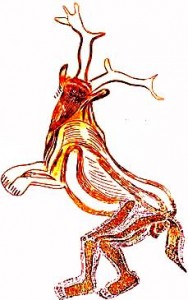
(The above image is a cave painting of a shaman found at Les Trois Freres Cave in France dating approximately 14,000 B.C.E., making it the oldest known depiction of a shaman. The image and further explanation can be found at :Sofiatopia.org and mask-and-more-masks.com .)
An urban planner works within a complex urban environment,
composed of an ever changing physical and human environment and where there are
multiple stakeholders at various scales. Within this chaos, a planner must use
his/her skills to navigate through problems, perceive the networked
relationships, analyze trends, guide/advise decision-makers, challenge the status
quo and develop plans and policies to improve the city/region that s/he is
employed.
In this environment, the planner cannot have the perception
of him/herself as a ‘good soldier ‘merely implementing regulations, objectively
presenting data or changes in regulations or implementing directives of
decision-makers. S(he) must conceptually and metaphorically must perceive
themselves as a modern day shaman.
A shaman would lead his/her tribe on vision quests. This can be translated into a planner enabling
citizens and decision-makers to think about the present and visualize a better
future (not a utopia) that would lead to a better and more just urban
environment at any scale; presenting data through spatial technologies and
through innovative modeling that may enhance a vision or lead to better
policies (the magic of technology); and establishing personal contacts with
those at all levels so that he/she can be a translate their interests to
others. Although this process is not
new, the concept of a planner being a shaman energizes it beyond mere presentations
into a dynamic one.
A shaman provokes his tribe, sometimes also acting as
trickster. In a complex and chaotic world, there is a need for persons to
create ripples and sometimes disturbances ‘in the vortex’ to cause change. A
urban planner thorough by what as seen as foolish by one action can open up new
ways. This could be as simple as riding
a bike to work which would appear foolish to some. This one ‘foolish’ action
might be the impetus for a discussion about energy conservations and eventually
the establishment of bicycle lanes or exclusive bicycle pathways.
Shape shifting is often performed by shamans a means of
mediation for members of the tribe.--to become an animal or person that will
relate to person for the purpose of
communication. Shape shifting is a metaphor for adaptation and is one to
the key concepts in complexity. Urban planners must likewise be adaptive and ‘shape-shift’
to fit their peculiar environment. This may be a simple as ‘dressing down’ or
making language approachable when talking to a group of citizens.
A shaman is not a decision-maker, but is nonetheless an
important leader in the tribe. He is
also trained through many years to be a servant/leader of his tribe. Urban planners in turn have at least four
years and often a Masters in urban/regional planning. They also play key roles in the
community. However, a shaman if he is
not doing well is often killed This
fortunately is not the fate of the most urban planners as s(he is not held
responsible for the to the success of the plans.
In summary, what does using the metaphor of a shaman mean to
urban planners? While many of the
methods of urban planning remain the same, the delivery and the ‘aura’ changes
because the urban planner will see his/herself in a different perspective. As
seeing oneself as not just a public servant, but as
leader/servant/visionary/trickster (a metaphorical shaman), this changes the
whole perspective of being a professional urban planner. It also takes this
role outside of the bounds of modernism and one places it within compatible
with complex systems and complexity theory, maybe even within the metaphorical
realm of quantum mechanics
The idea of urban planner as shaman was first introduced in
my article, Complexity
and Urban Planning, published in Urbana:
Urban Affairs and Public Policy. It
was also republished with a collection of articles in the book edited by Michael
A. McAdams, Ivani Vassoler-Froelich and Jesús Treviño Cantú , The Geography,
Politics, and Architecture of Cities: Studies in the Creation and
Complexification of Culture The Edwin Mellen Press. (June 2012).( For more
information, go to http://www.mellenpress.com/mellenpress.cfm?bookid=8568&pc=9
.)

No comments:
Post a Comment